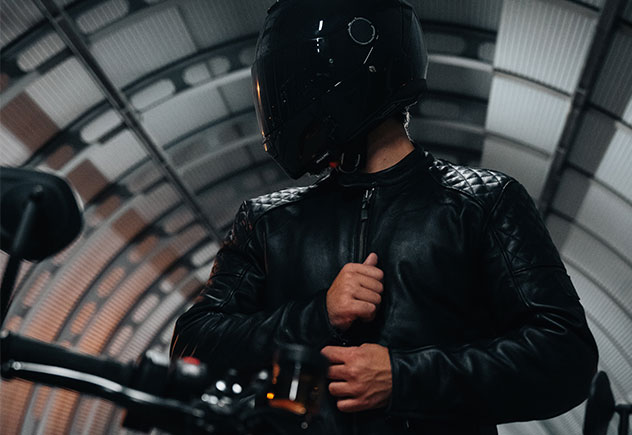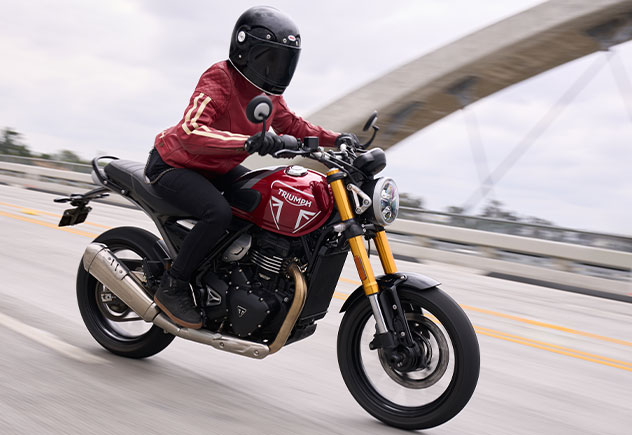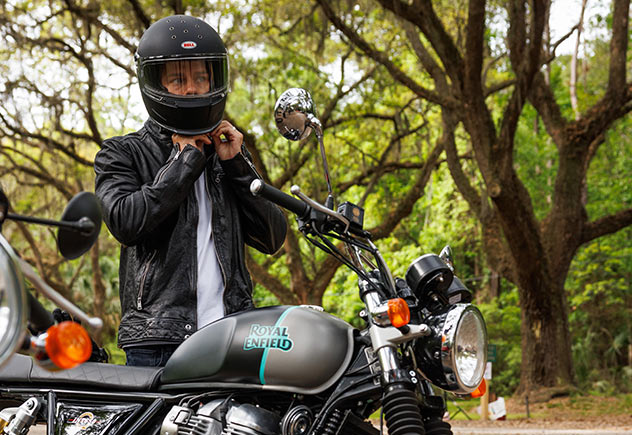Riding Gear - Motorcycles
ALL THE GEAR ALL THE TIME (ATGATT)
If you ride, you know – All the Gear, All the Time (ATGATT). Safety first. The right gear, and all the right gear, will help minimize potential injuries. Riding gear is available for smaller body types, larger types, females, males and children. Consider visibility. The brighter the colours, the easier it is to be seen.
The best way to fit riding gear is to try it on while sitting on a bike similar to yours. Make sure the helmet and the jacket work together and don’t bunch up or puff out. Jackets and suits are designed in riding position. Some jackets and pants zip or snap together for added protection. This feature also minimizes drafts coming up your back.


Protective riding gear is constructed of many different materials. Leather is the original material and still offers the best protection if it’s motorcycle grade. There are many variations of textile fabrics including Cordura nylon, Kevlar, polyester and mesh fabrics. Generally the heavier the fabric the better the protection. Specifically designed motorcycle apparel should have the following features including venting, removable liners, body armour and special coating for weather protection.
GORE-TEX is a name brand used in motorcycle clothing to waterproof the garment while still allowing it to breathe. This is not a protective layer but it is a membrane in between the outer and inner layers. General rule of thumb is that the more breathable the membrane the less waterproof it is. The same applies with venting, the more vents the less waterproof.
Air bag vests are the newest piece of protective gear. They are divided into two types, tethered and electronic. The tethered type is less expensive but requires you to tether to the bike. If you come off your bike, the tug on the tether cord will activate the air bag. The electronic type has gyroscopes and motion sensors that will detect a sudden change in direction and deploy the air bag. This type of protection is becoming mandatory in most road race organizations.
If you are a believer in Murphy’s Law you will know that if you wear all the gear all the time you won’t need it. The time you leave it in the closet is the time you will need it most.

Back in the early days, you could buy any colour of riding gear as long as it was black. The trouble with black or black and grey is that you can’t be seen. Some riders did venture into blue, red, green and yellow gear, but mostly to match their favourite bike.
Now we have High Visibility gear and reflective striping and piping. It helps to dress to be seen. Do all that you can do to be seen by other motorists. The higher you wear High Visibility gear on your body the more visible you will be.
Let’s talk about helmets. On-road helmets come in 3 basic variations. The Shorty (1/2) helmet, the Open Face (3/4) helmet and the Full Face helmet. The more coverage, the more protection. There is also a hybrid or flip-up helmet.
The most important consideration when buying a helmet is fit. Some heads are round-shaped and some are oval. You need to spend some time at a dealership and try a few on until you find the one that’s just right. Be wary of knockoffs. If the price seems too good to be true, it probably is. Higher-end helmets offer customizable liners that will allow you to change liner pieces to get the best fit.
In Canada, helmet laws and ratings are stipulated by the province or territory. Check with your home province’s Ministry of Transportation for information regarding your province’s helmet requirements.
Specialized motorcycle protective jackets and pants shouldn’t be considered optional. Today’s technology has removed the common objections that it’s too hot, too bulky or too uncomfortable to wear protective gear. Effective riding gear will be your best protection.
Leather was the original material-of-choice for protection and it still is on the race track. On the street, riders can also access Cordura nylon and other man-made fabrics. Considerations include water resistance, breathability, venting, removable thermal liners and body armour.
Jacket length is also a consideration. Sport and cruiser riders will prefer a shorter waist length jacket. Touring and adventure riders might prefer the greater coverage of a 3/4 length jacket.
The type of jacket you buy can be influenced by where you live and what you ride. Your area may require more waterproof gear. Other areas may benefit from thermal liners. Some jackets offer all features, waterproof, breathable, venting and armour plus style.
For riding in the rain you can take one of two options: You can wear a GORE-TEX or similar riding jacket and pants or you can wear a rain suit over top of your riding gear. Please note that a rain suit does not offer enough protection to be worn instead of riding gear.
Body armour is very popular. It generally covers impact parts like shoulders, elbows and spine. New technology like D30 is soft and supple body armour until an impact, at which point it hardens up to absorb the shock. Lower body protection is pretty much a mirror of upper body protection. Armour protects knees and hips instead of shoulders and elbows.The same materials and features exist.
Many long-time riders will collect riding jackets like hockey cards. They don’t tend to wear out, so your collection could include a cold weather jacket, a wet weather jacket and a hot weather mesh jacket.
Your hands initiate almost everything you do. Make sure you protect your hands. Motorcycle specific gloves are a necessity. Once again leather will provide the most protection when choosing gloves. A hybrid of leather and textile is another choice and these can be more hot-climate friendly. Pure textile gloves provide the least protection. Textile gloves designed for off road riding and motocross will provide little to no protection in the event you fall and go palms down on the pavement.
Boots are an often overlooked piece of safety equipment. Boots need to cover and protect your ankles. They should have proper fasteners to stay on your feet. Footwear with laces may be stylish but make sure laces don’t get caught up in the motorcycle’s operating parts. When choosing boots, leather is still king. Synthetic leather-like material is also very popular in sportbike boots. Some boots offer GORE-TEX or similar waterproof membranes. Touring riders gravitate towards the protection from the elements. Sportbike riders may prefer boots that vent.
Many riding gear manufacturers are trending towards a motorcycle-specific hi-top style of running shoe. They offer ankle protection and aren’t too out of place in a restaurant or coffee shop. Again, though, make sure to secure the laces.
There are more women riding motorcycles now than ever before. And the industry has embraced this evolution with more responsive gear.
And it’s not all pink!
Jackets are specifically designed for a woman’s body shape. Waist adjustments and side hip zippers allow for differing body types. Pants have higher waists and provide the same material and armour for protection. Gloves and boots are specifically sized for women, not just small versions of men’s gear.
Women’s gear offers all the protective and comfort features as men’s gear. Features like body armour, venting, removable liners and waterproof membranes are common. You can choose either leather or textile fabrics or a combination of both. A variety of colours are offered to ensure fashion and function meet.
